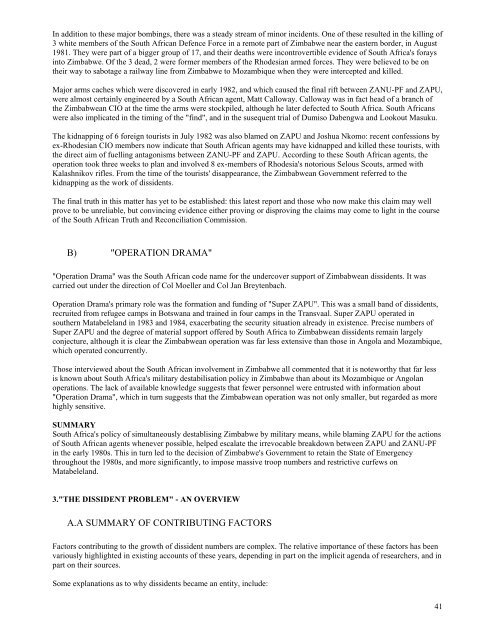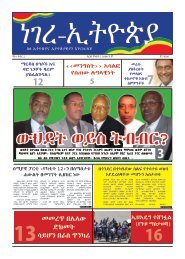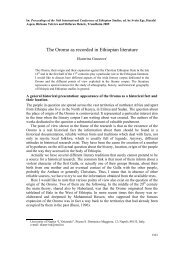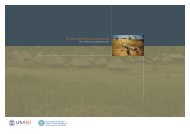MatabelelandReport
MatabelelandReport
MatabelelandReport
You also want an ePaper? Increase the reach of your titles
YUMPU automatically turns print PDFs into web optimized ePapers that Google loves.
In addition to these major bombings, there was a steady stream of minor incidents. One of these resulted in the killing of<br />
3 white members of the South African Defence Force in a remote part of Zimbabwe near the eastern border, in August<br />
1981. They were part of a bigger group of 17, and their deaths were incontrovertible evidence of South Africa's forays<br />
into Zimbabwe. Of the 3 dead, 2 were former members of the Rhodesian armed forces. They were believed to be on<br />
their way to sabotage a railway line from Zimbabwe to Mozambique when they were intercepted and killed.<br />
Major arms caches which were discovered in early 1982, and which caused the final rift between ZANU-PF and ZAPU,<br />
were almost certainly engineered by a South African agent, Matt Calloway. Calloway was in fact head of a branch of<br />
the Zimbabwean CIO at the time the arms were stockpiled, although he later defected to South Africa. South Africans<br />
were also implicated in the timing of the "find", and in the susequent trial of Dumiso Dabengwa and Lookout Masuku.<br />
The kidnapping of 6 foreign tourists in July 1982 was also blamed on ZAPU and Joshua Nkomo: recent confessions by<br />
ex-Rhodesian CIO members now indicate that South African agents may have kidnapped and killed these tourists, with<br />
the direct aim of fuelling antagonisms between ZANU-PF and ZAPU. According to these South African agents, the<br />
operation took three weeks to plan and involved 8 ex-members of Rhodesia's notorious Selous Scouts, armed with<br />
Kalashnikov rifles. From the time of the tourists' disappearance, the Zimbabwean Government referred to the<br />
kidnapping as the work of dissidents.<br />
The final truth in this matter has yet to be established: this latest report and those who now make this claim may well<br />
prove to be unreliable, but convincing evidence either proving or disproving the claims may come to light in the course<br />
of the South African Truth and Reconciliation Commission.<br />
B) "OPERATION DRAMA"<br />
"Operation Drama" was the South African code name for the undercover support of Zimbabwean dissidents. It was<br />
carried out under the direction of Col Moeller and Col Jan Breytenbach.<br />
Operation Drama's primary role was the formation and funding of "Super ZAPU". This was a small band of dissidents,<br />
recruited from refugee camps in Botswana and trained in four camps in the Transvaal. Super ZAPU operated in<br />
southern Matabeleland in 1983 and 1984, exacerbating the security situation already in existence. Precise numbers of<br />
Super ZAPU and the degree of material support offered by South Africa to Zimbabwean dissidents remain largely<br />
conjecture, although it is clear the Zimbabwean operation was far less extensive than those in Angola and Mozambique,<br />
which operated concurrently.<br />
Those interviewed about the South African involvement in Zimbabwe all commented that it is noteworthy that far less<br />
is known about South Africa's military destabilisation policy in Zimbabwe than about its Mozambique or Angolan<br />
operations. The lack of available knowledge suggests that fewer personnel were entrusted with information about<br />
"Operation Drama", which in turn suggests that the Zimbabwean operation was not only smaller, but regarded as more<br />
highly sensitive.<br />
SUMMARY<br />
South Africa's policy of simultaneously destablising Zimbabwe by military means, while blaming ZAPU for the actions<br />
of South African agents whenever possible, helped escalate the irrevocable breakdown between ZAPU and ZANU-PF<br />
in the early 1980s. This in turn led to the decision of Zimbabwe's Government to retain the State of Emergency<br />
throughout the 1980s, and more significantly, to impose massive troop numbers and restrictive curfews on<br />
Matabeleland.<br />
3."THE DISSIDENT PROBLEM" - AN OVERVIEW<br />
A.A SUMMARY OF CONTRIBUTING FACTORS<br />
Factors contributing to the growth of dissident numbers are complex. The relative importance of these factors has been<br />
variously highlighted in existing accounts of these years, depending in part on the implicit agenda of researchers, and in<br />
part on their sources.<br />
Some explanations as to why dissidents became an entity, include:<br />
41







